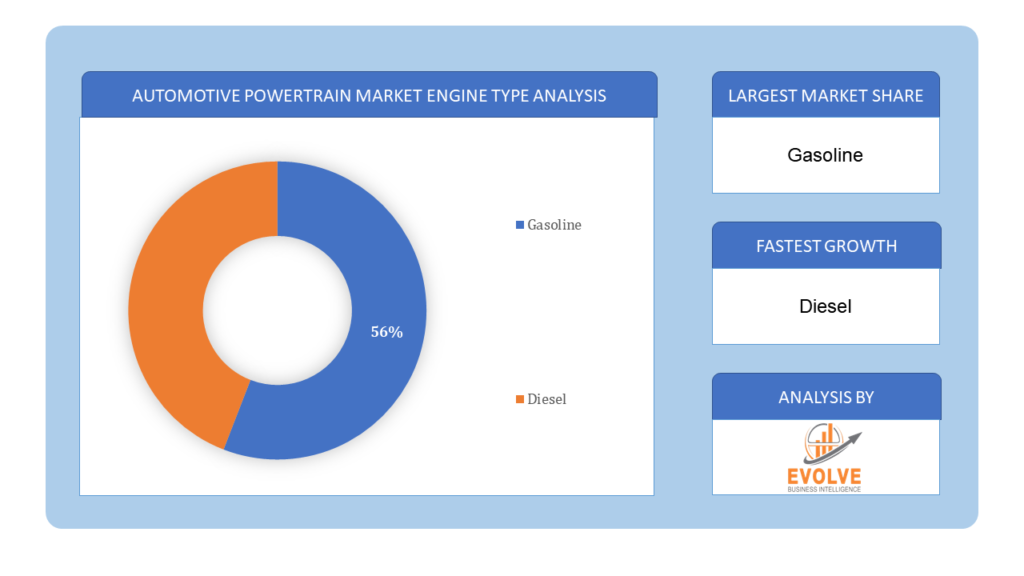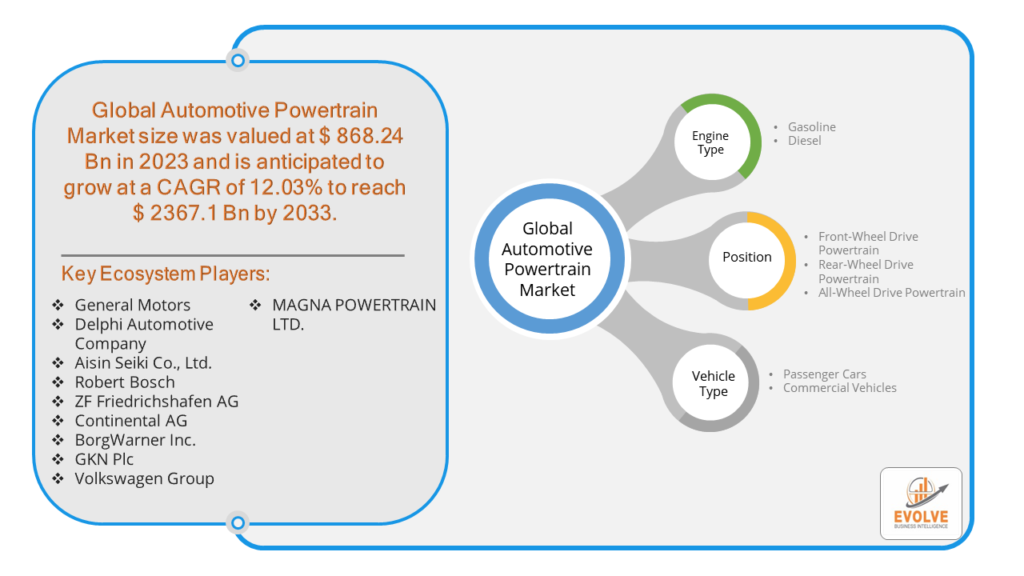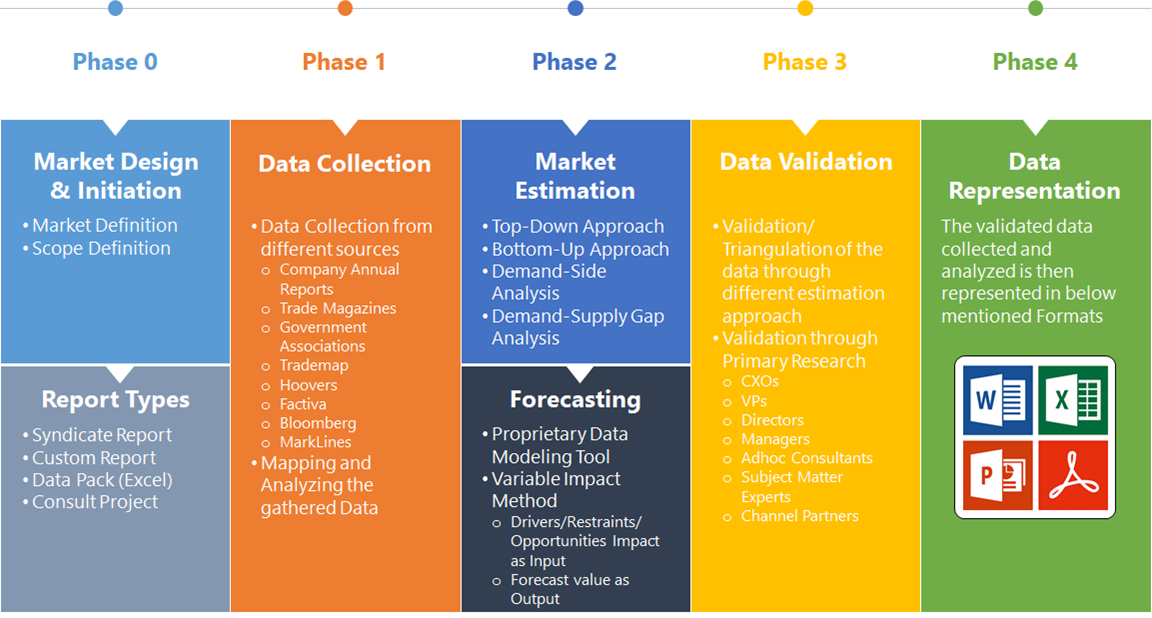Automotive Powertrain Market Overview
The Automotive Powertrain Market Size is expected to reach USD 2367.1 Billion by 2033. The Automotive Powertrain industry size accounted for USD 868.24 Billion in 2023 and is expected to expand at a compound annual growth rate (CAGR) of 12.03% from 2023 to 2033. The automotive powertrain refers to the integrated system within a vehicle responsible for generating and transmitting power to the wheels, enabling propulsion. It typically encompasses components such as the engine, transmission, driveshaft, differential, and wheels, working in tandem to deliver mechanical energy for vehicle movement. The powertrain plays a fundamental role in determining a vehicle’s performance, efficiency, and drivability, making it a crucial focus area for automotive engineering and development.
Global Automotive Powertrain Market Synopsis
The Automotive Powertrain market experienced a profound and transformative shift as a result of the COVID-19 pandemic. Initially, disruptions in global supply chains and manufacturing operations led to significant production slowdowns and supply shortages across the automotive industry. Additionally, decreased consumer demand and economic uncertainty resulted in a notable decline in vehicle sales, prompting automakers to reevaluate their production strategies and investment priorities. However, amidst these challenges, the pandemic accelerated existing trends such as the transition towards electric and hybrid powertrains. Governments and automotive manufacturers intensified efforts to meet sustainability goals, leading to increased investments in alternative propulsion technologies. This paradigm shift not only reshaped the Automotive Powertrain market but also underscored the importance of adaptability and resilience in the face of unforeseen disruptions.
Automotive Powertrain Market Dynamics
The major factors that have impacted the growth of Automotive Powertrain are as follows:
Drivers:
Ø Regulatory pressures and emission reduction goals
Increasingly stringent emissions regulations worldwide are driving the Automotive Powertrain market towards more efficient and environmentally friendly technologies. Automakers are incentivized to develop powertrains that produce lower emissions and consume less fuel, leading to innovation in hybrid, electric, and alternative fuel powertrain systems.
Restraint:
- High development and production costs
The Automotive Powertrain market is the high cost associated with the development and production of advanced powertrain technologies. Research and development expenses for new propulsion systems, as well as the investment required to retool manufacturing facilities, can pose significant financial challenges for automakers, especially during economic downturns or periods of uncertainty.
Opportunity:
⮚ Shift towards electric and hybrid vehicles
The growing consumer demand for electric and hybrid vehicles presents a significant opportunity for the Automotive Powertrain market. As concerns about climate change and air pollution rise, more consumers are seeking vehicles with lower emissions and greater fuel efficiency. This trend creates opportunities for automakers to invest in electric powertrains, battery technology, and hybrid systems to meet market demand and gain a competitive edge.
Automotive Powertrain Segment Overview
By Engine Type
 Based on Engine Type, the market is segmented based on Gasoline and Diesel. The Gasoline segment is positioned for notable expansion, fueling growth in the Automotive Powertrain market due to ongoing demand for internal combustion engine vehicles and advancements in gasoline engine technology, enhancing performance and efficiency to meet regulatory standards and consumer preferences.
Based on Engine Type, the market is segmented based on Gasoline and Diesel. The Gasoline segment is positioned for notable expansion, fueling growth in the Automotive Powertrain market due to ongoing demand for internal combustion engine vehicles and advancements in gasoline engine technology, enhancing performance and efficiency to meet regulatory standards and consumer preferences.
By Position
Based on Position, the market has been divided into Front-Wheel Drive Powertrain, Rear-Wheel Drive Powertrain and All-Wheel Drive Powertrain. Front-wheel drive (FWD) powertrains are emerging as the predominant force in the Automotive Powertrain Market, driven by their widespread adoption in passenger vehicles worldwide. FWD systems offer advantages such as efficient packaging, improved fuel economy, and enhanced traction in various driving conditions, making them increasingly popular among automakers and consumers alike.
By Vehicle Type
Based on Vehicle Type, the market has been divided into Passenger Cars, and Commercial Vehicles. The dominance of passenger cars in the Automotive Powertrain Market is evident due to their widespread use and demand globally. Passenger cars represent a significant portion of vehicle sales, driving the adoption of various powertrain technologies. With consumers increasingly prioritizing factors such as fuel efficiency, performance, and environmental impact, automakers are focused on developing powertrains that meet these demands.
Global Automotive Powertrain Market Regional Analysis
Based on region, the global Automotive Powertrain market has been divided into North America, Europe, Asia-Pacific, the Middle East & Africa, and Latin America. North America is projected to dominate the use of the Automotive Powertrain market followed by the Asia-Pacific and Europe regions.
 Automotive Powertrain North America Market
Automotive Powertrain North America Market
North America has consistently maintained a dominant position in the Automotive Powertrain market, owing to its robust automotive manufacturing infrastructure, technological innovation, and strong consumer demand for vehicles. The region’s leading role in automotive production and engineering allows it to drive advancements in powertrain technologies, including hybrid and electric propulsion systems, to meet regulatory standards and consumer preferences. Additionally, North America’s large market size and diverse automotive landscape contribute to its sustained prominence in the global Automotive Powertrain market.
Automotive Powertrain Asia-Pacific Market
The Asia-Pacific region has emerged as a rapidly growing market for the Automotive Powertrain industry, fueled by several factors including increasing vehicle production, rising consumer demand, and government initiatives promoting sustainable mobility solutions. Countries such as China, Japan, South Korea, and India are leading the way in automotive manufacturing and innovation, driving the adoption of advanced powertrain technologies. Additionally, the region’s expanding middle class and urbanization trends are driving demand for passenger vehicles, further boosting the Automotive Powertrain market. With a growing emphasis on environmental sustainability and fuel efficiency, the Asia-Pacific region presents significant growth opportunities for powertrain manufacturers and suppliers.
Competitive Landscape
The Global Automotive Powertrain market is highly competitive, with numerous players offering a wide range of software solutions. The competitive landscape is characterized by the presence of established companies, as well as emerging startups and niche players. To increase their market position and attract a wide consumer base, the businesses are employing various strategies, such as product launches, and strategic alliances.
Prominent Players:
- General Motors
- Delphi Automotive Company
- Aisin Seiki Co., Ltd.
- Robert Bosch
- ZF Friedrichshafen AG
- Continental AG
- BorgWarner Inc.
- GKN Plc
- Volkswagen Group
- MAGNA POWERTRAIN LTD.
Key Development
In July 2021, Valeo and Omega Seiki Mobility (OSM) signed a Memorandum of Understanding (MoU), with Valeo set to provide electric powertrains for OSM’s lineup of vehicles, focusing on a three-wheeler commercial vehicle range in India.
Also in July 2021, Volvo Cars and Geely Automotive formed a strategic partnership, establishing a joint venture named “Aurobay,” aimed at the development and supply of powertrains.
Scope of the Report
Global Automotive Powertrain Market, by Engine Type
- Gasoline
- Diesel
Global Automotive Powertrain Market, by Position
- Front-Wheel Drive Powertrain
- Rear-Wheel Drive Powertrain
- All-Wheel Drive Powertrain
Global Automotive Powertrain Market, by Vehicle Type
- Passenger Cars
- Commercial Vehicles
Global Automotive Powertrain Market, by Region
- North America
- US
- Canada
- Mexico
- Europe
- UK
- Germany
- France
- Italy
- Spain
- Benelux
- Nordic
- Rest of Europe
- Asia Pacific
- China
- Japan
- South Korea
- Indonesia
- Austalia
- Malaysia
- India
- Rest of Asia Pacific
- South America
- Brazil
- Argentina
- Rest of South America
- Middle East & Africa
- Saudi Arabia
- UAE
- Egypt
- South Africa
- Rest of Middle East & Africa
| Parameters | Indicators |
|---|---|
| Market Size | 2033: $2367.1 Billion |
| CAGR | 12.03% CAGR (2023-2033) |
| Base year | 2022 |
| Forecast Period | 2023-2033 |
| Historical Data | 2021 |
| Report Coverage | Revenue Forecast, Competitive Landscape, Growth Factors, and Trends |
| Key Segmentations | Engine Type, Position, Vehicle Type |
| Geographies Covered | North America, Europe, Asia-Pacific, Latin America, Middle East, Africa |
| Key Vendors | General Motors, Delphi Automotive Company, Aisin Seiki Co., Ltd., Robert Bosch, ZF Friedrichshafen AG, Continental AG, BorgWarner Inc., GKN Plc, Volkswagen Group, MAGNA POWERTRAIN LTD |
| Key Market Opportunities | • Growing market for electric and hybrid vehicles, spurred by increasing environmental awareness and government incentives. • Technological innovation presenting opportunities for the development of more efficient and high-performance powertrains |
| Key Market Drivers | • Regulatory requirements and emission standards driving demand for cleaner and more fuel-efficient powertrain technologies. • Advancements in technology, such as electric and hybrid propulsion systems, responding to consumer preferences for environmentally friendly vehicles. |
REPORT CONTENT BRIEF:
- High-level analysis of the current and future Automotive Powertrain market trends and opportunities
- Detailed analysis of current market drivers, restraining factors, and opportunities in the future
- Automotive Powertrain market historical market size for the year 2021, and forecast from 2023 to 2033
- Automotive Powertrain market share analysis at each product level
- Competitor analysis with detailed insight into its product segment, Government & Defense strength, and strategies adopted.
- Identifies key strategies adopted including product launches and developments, mergers and acquisitions, joint ventures, collaborations, and partnerships as well as funding taken and investment done, among others.
- To identify and understand the various factors involved in the global Automotive Powertrain market affected by the pandemic
- To provide a detailed insight into the major companies operating in the market. The profiling will include the Government & Defense health of the company’s past 2-3 years with segmental and regional revenue breakup, product offering, recent developments, SWOT analysis, and key strategies.





